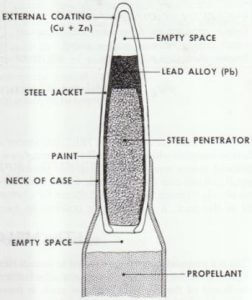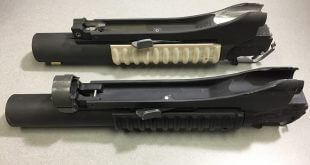This is Part 3 in our series of unconstitutional and illogical gun control measures that need to disappear now that Donald Trump is President. Today, we’re focusing on “armor piercing” ammunition.
Let’s dive right in…
- Definition of Armor Piercing Ammunition (18 U.S.C., § 921(A)(17))
We support law enforcement wholeheartedly. But the legal definition of “armor piercing” ammunition is too broad and leaves the Federal government with too much latitude to ban ammunition in lawful common use.
Here is how it is defined in the law:
(B) The term “armor piercing ammunition” means-
(i) A projectile or projectile core which may be used in a handgun and which is constructed entirely (excluding the presence of traces of other substances) from one or a combination of tungsten alloys, steel, iron, brass, bronze, beryllium copper, or depleted uranium; or
(ii) A full jacketed projectile larger than .22 caliber designed and intended for use in a handgun and whose jacket has a weight of more than 25 percent of the total weight of the projectile.
So let’s unpack this. In order for a bullet to be “armor piercing” it must have a non-lead core made entirely from the metals listed above or it must be a bullet larger than .22 cal designed for use in a handgun with a jacket more than 1/4 of the total weight.
We have seen in recent years that the ATF has used this provision to ban types of ammunition that technically do not qualify under the law.
Imported Russian 5.45×39 ammunition, designed for use in the AK-74 rifle, was banned from importation in 2014. The ATF argued that because the projectiles have a steel cone, and because a company filed for permission to import a pistol chambered in 5.45×39, the ammunition fell under the definition of “armor piercing.”
Part ii of the law cannot apply to this ammunition because the bullet is technically .22 caliber. So only Part i – having a non-lead core – could possibly apply.
 On the right you will find a diagram of how the 5.45×39 bullet was designed. As you can see, the Soviets deliberately added a lead alloy to the core of the projectile. The only way that this could possibly be defined as “armor piercing” is if the lead alloy is simply a trace elements.
On the right you will find a diagram of how the 5.45×39 bullet was designed. As you can see, the Soviets deliberately added a lead alloy to the core of the projectile. The only way that this could possibly be defined as “armor piercing” is if the lead alloy is simply a trace elements.
Trace elements aren’t usually specifically identified and labeled in diagrams…
The ATF also tried to ban popular M855 5.56×45 ammunition in 2015. This ammunition is standard issue in the US Military because the bullet features a steel cone designed to pierce Soviet pot-metal helmets at distance.
These bullets should have been exempted because they are .22 caliber and have a core deliberately made of lead. But the ATF attempted to ban it anyway. Only when Americans began to contact Congressmen and Senators did the ATF finally decide to back down.
What we learned from these ban attempts is that the definition of armor-piercing ammunition is simply too vaguely written to allow unelected bureaucrats to enforce it.
It also provides anti-gun activists with too much power to influence ammunition bans. In order for ammunition to be banned, a commercially-available firearm in that caliber must exist. But as we saw in the case of the 5.45×39 ban, there was never a AK-74 Pistol for sale on the market.
The ATF used a foreign company’s application to import a pistol as enough justification to ban the ammunition.
Environmentalists have spent years trying to ban lead ammunition in hunting. Thankfully, Trump’s Interior Secretary just repealed an Obama-era regulation that would have done just that.
If lead ammunition is banned for hunting, then hunters would have to use ammunition made from metals that are listed in the definition of “armor piercing ammunition.” Then, all it would take was one person creating a pistol in that caliber and the entire class of ammunition would be banned.
We support efforts to protect law enforcement officers, but not at the expense of potentially criminalizing lawful ammunition ownership.
Part 4 coming soon.
 Second United
Second United




